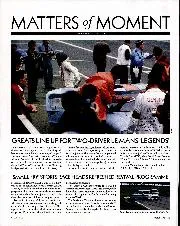
Matters of moment, June 2003
Greats line up for two-driver Le Mans 'Legends' Sir Stirling Moss and Phil Hill are just two of the star names lining up for the Le Mans Legends historic race…
One of the most influential of early racing car constructors was the multi-national but Spanish-originated, and later French-based, Hispano-Suiza marque.
Under the technical direction of Swiss engineer Marc Birkigt, the marque’s pioneering in-line four-cylinder works cars hit their stride in September 1910 when Italian technician/driver Paolo Zuccarelli won at Ostende in Belgium.
Two weeks later, he toppled the might of Peugeot by winning the great Coupe de l’Auto Voiturette race at Boulogne. It was akin to winning a Formula 2 race at Monaco today but with enormous, glittery, market-influencing, money-earning knobs on.
Hispano-Suiza’s most charismatic and supportive fan was then 24-year old King Alfonso XIII of Spain. He’d inherited his crown at birth, as his father had died months earlier. As a new-born, he’d been carried naked to the Spanish prime minister on a silver tray.
“We bounced back from the grip of disease 100 years ago, we will again”
The young king grew up loving his cars. He bought his first Hispano-Suiza in 1907 but made it obvious to Birkigt that he thought the company’s ‘carriage trade’ products were rather tame. Birkigt was thinking similarly and, in 1909, he designed a long-stroke T-head four-cylinder in-line water-cooled engine for small-capacity voiturette racing.
One powered Zuccarelli’s victorious car in the Coupe de l’Auto race at an average speed of 8mph faster than the previous year’s Peugeot. Hispano’s technical advance effectively killed the single- and twin-cylinder designs that had previously ruled the class.
Birkigt then productionised a development of his winning design, effectively the taproot of the modern sports car genre. King Alfonso tried one and enthusiastically placed an order. The model would become the Hispano-Suiza Alfonso XIII. It was incredibly futuristic, looking more like an open sports car of the 1920s, or even ’30s, than as a product of 1911-12. It was good for 75mph, or 90mph when race-tuned. Imagine that in 1912-14. There was a car in which a rampant young blade could cut a dash, as long as he didn’t kill himself or get arrested first.
But in 1918, the Spanish Flu pandemic began. While war-battered allies suppressed news of the erupting disease, neutral Spain had a free press. When King Alfonso became seriously ill with it, news of his affliction spread as fast and as far as the disease.
It was because of this that the pandemic, which continued into 1920, was labelled ‘The Spanish Flu’, even though it had arguably emerged in a British Army troop staging and hospital camp at Etaples, in France. Or in Haskell County, Kansas, or Boston, Massachusetts… or China, as some have claimed in more recent studies into the Spanish Flu’s origins.
To the Spanish, their poor king’s illness – from which he recovered – became known as La Pesadilla, The Nightmare, and in French as La Grippe Espagnole. With estimates of 17 million up to as high as 100 million deaths worldwide, and five times as many said to have been infected, it was an utterly cataclysmic addition to the Great War’s already very heavy cost.
But human enterprise, endeavour and pursuit of fun has always endured, and surely will again.
Among the 1919-20 survivors were many thousands of often brand-new car and motor sport enthusiasts whose first experience of motoring had come during wartime service.
Instead of being confined to stepping back from the roadside as the toffs swept by in chauffeured limousines, the motoring masses began to emerge. And with them, motor sport began to be resurrected.
In May 1919, the Indy 500 Speedway race was revived after a two-year absence, down in undamaged Sicily, Count Florio breathed new life into his Targa Florio classic. Four-cylinder in-line and water-cooled Peugeots won both events.
At least 16 speed hillclimbs were also run in the first season of the new peace, nine of them in isolated Australia, one in the US and one at South Harting in England, won by Archie Frazer Nash’s GN.
Through 1920, Indy and the Targa were repeated, the Mugello road race was run in mainland Italy, the Elgin Trophy road race in Illinois, plus a brace of voiturette races at Le Mans.
Over 40 hillclimbs took place, more than half of them in Europe, nine in Australia, and at least eight in England and Wales, on Kop Hill near Princes Risborough, Rhiwbina near Cardiff, Shelsley Walsh, Style Kop, South Harting, Sutton Bank, Spread Eagle near Melbury, Holme Moss and Angel Bank.
One hundred years ago, our forefathers were bouncing back after being freed from the grip of a disease. It happened then, and it shall again once the current coronavirus pandemic passes and the chance for motor sport’s return arises.